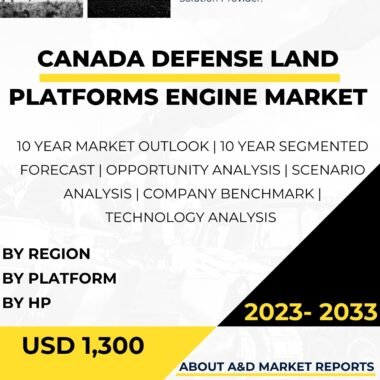Description
Canada Armored Vehicle Market
The Canada Armored Vehicle Market has significantly contributed to the country’s defense capabilities and its ability to operate effectively in various operational scenarios. Armored vehicles are military platforms designed to provide enhanced protection to personnel and equipment while maintaining mobility and firepower on the battlefield. These versatile assets are essential components of the Canadian Armed Forces, supporting a range of missions, including combat operations, peacekeeping, humanitarian assistance, and disaster relief.
The deployment of armored vehicles aligns with Canada’s commitment to modernizing its land force capabilities and providing troops with the necessary tools to address emerging threats and security challenges effectively. Armored vehicles serve as the backbone of mechanized infantry units, enabling soldiers to move swiftly and safely across diverse terrains, including urban areas and challenging landscapes.
One of the primary objectives of Canada’s armored vehicle program is to enhance the protection and survivability of troops during ground operations. These vehicles are equipped with advanced armor and ballistic protection, shielding occupants from small arms fire, shrapnel, and improvised explosive devices (IEDs).
Additionally, the mobility of armored vehicles facilitates maneuverability on the battlefield, providing infantry units with the tactical flexibility and responsiveness required for offensive and defensive operations.
The Canadian Armed Forces deploy a range of armored vehicles to meet different mission requirements. Some vehicles are optimized for reconnaissance and patrol duties, while others are heavily armored and equipped with firepower to engage enemy targets during combat.
These vehicles are also equipped with advanced communication and battlefield management systems, enabling seamless coordination between units and enhancing situational awareness on the battlefield.
Furthermore, Canada’s armored vehicles are designed to be versatile and modular, allowing them to be configured for various roles and missions. They can be equipped with different weapon systems, communication suites, and specialized equipment, adapting to the specific requirements of different operational scenarios.
Canada’s armored vehicle fleet includes infantry fighting vehicles (IFVs), armored personnel carriers (APCs), reconnaissance vehicles, and mine-resistant ambush-protected (MRAP) vehicles. These vehicles support a wide range of missions, from rapid deployment and offensive operations to peacekeeping and stabilization efforts.
Moreover, Canada’s armored vehicles are often used in conjunction with other military assets, such as tanks, artillery, and air support, to create a combined arms approach on the battlefield. This integrated effort maximizes the effectiveness of ground operations and ensures that the Canadian Armed Forces can respond effectively to various threats and operational scenarios.
Canada’s commitment to safety and operational excellence is evident in the training and readiness of personnel operating armored vehicles. The Canadian Armed Forces prioritize comprehensive training programs to ensure that personnel can effectively handle these complex and sophisticated vehicles in different environments.
Additionally, the Canadian government invests in ongoing research, development, and modernization of its armored vehicle fleet. These investments aim to improve the protection, mobility, and firepower of armored vehicles, ensuring that they remain technologically advanced and capable of addressing evolving threats on the battlefield.
The Canadian Armed Forces also collaborate with domestic and international defense industry partners to leverage expertise and advancements in armored vehicle technology. These collaborations contribute to the evolution of armored vehicle capabilities and foster a thriving domestic defense industry.
Canada’s armored vehicle program is subject to strict adherence to international laws and protocols governing arms control and the use of military vehicles. The Canadian government maintains robust export control mechanisms to prevent the unauthorized proliferation of armored vehicles and related technologies.
Canada’s commitment to environmental sustainability and responsible defense practices is reflected in the responsible management of its armored vehicle fleet. The government ensures that the disposal and recycling of obsolete or surplus armored vehicles comply with environmental regulations and safety standards.
Furthermore, the Canadian Armed Forces continually assess the performance and effectiveness of its armored vehicle fleet to address emerging operational requirements and adapt to changing security environments. These assessments inform future procurement and modernization decisions, ensuring that the Canadian Armed Forces maintain a technologically advanced and capable armored vehicle fleet.
In conclusion, Canada’s adoption of armored vehicles is integral to its ground operations and military capabilities. These vehicles provide infantry troops with enhanced protection, mobility, and firepower, enabling them to maneuver swiftly and safely on the battlefield.
Canada’s armored vehicle fleet, which includes IFVs, APCs, reconnaissance vehicles, and MRAPs, supports a wide range of missions, from combat operations to peacekeeping and humanitarian assistance.
The commitment to safety, ongoing research, and collaboration with domestic and international defense industry partners ensures that Canada’s armored vehicle fleet remains technologically advanced and adaptable to address evolving threats.
Adherence to international arms control regulations and responsible environmental practices underscores Canada’s commitment to upholding ethical and sustainable defense practices.
As Canada’s security requirements continue to evolve, the Canadian Armed Forces will undoubtedly continue to invest in advancing its armored vehicle capabilities to maintain its position as a capable and agile military force.




